
Missile Command is a 1980 shoot 'em up arcade video game developed and published by Atari, Inc. and licensed to Sega for Japanese and European releases. It was designed by Dave Theurer, who also designed Atari's vector graphics game Tempest from the same year. The game was released during the Cold War, and the player uses a trackball to defend six cities from intercontinental ballistic missiles by launching anti-ballistic missiles from three bases.

Pitfall! is a video game developed by David Crane for the Atari 2600 and released in 1982 by Activision. The player controls Pitfall Harry, who has a time limit of 20 minutes to seek treasure in a jungle. The game world is populated by enemies and hazards that variously cause the player to lose lives or points.
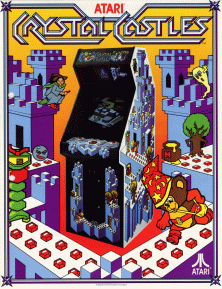
Crystal Castles is an arcade video game released by Atari, Inc. in 1983. The player controls Bentley Bear who has to collect gems located throughout trimetric-projected rendered castles while avoiding enemies, some of whom are after the gems as well.

Phoenix is a fixed shooter video game developed for arcades in Japan and released in 1980 by Taito. The player controls a space ship shooting at incoming enemies that fly from the top of the screen down towards the player's ship. There are five stages which repeat endlessly. The fifth is a fight against a large enemy spaceship, making Phoenix one of the first shooters with a boss battle, an element that would become common for the genre.
1982 was the peak year for the golden age of arcade video games as well as the second generation of video game consoles. Many games were released that would spawn franchises, or at least sequels, including Dig Dug, Pole Position, Mr. Do!, Zaxxon, Q*bert, Time Pilot and Pitfall! The year's highest-grossing video game was Namco's arcade game Pac-Man, for the third year in a row, while the year's best-selling home system was the Atari 2600. Additional video game consoles added to a crowded market, notably the ColecoVision and Atari 5200. Troubles at Atari late in the year triggered the video game crash of 1983.

Imagic was an American video game developer and publisher that created games initially for the Atari 2600. Founded in 1981 by corporate alumni of Atari, Inc. and Mattel, its best-selling titles were Atlantis, Cosmic Ark, and Demon Attack. Imagic also released games for Intellivision, ColecoVision, Atari 8-bit computers, TI-99/4A, IBM PCjr, VIC-20, Commodore 64, TRS-80 Color Computer, and Magnavox Odyssey². Their Odyssey² ports of Demon Attack and Atlantis were the only third-party releases for that system in America. The company never recovered from the video game crash of 1983 and was liquidated in 1986.

Venture is a fantasy-themed action game released as an arcade video game in 1981 by Exidy. Each level consists of a playable, overhead map view. Upon entering one of the rooms shown on the map, the game zooms in until the room fills the screen. As a round smiley-face named Winky, the goal is to collect the treasure in each of the rooms. Winky can shoot arrows at enemies which turn into slowly disintegrating corpses when hit. Corpses are deadly to the touch. Each room has a different layout, treasure, and enemies, and some rooms have special features, such as moving walls.
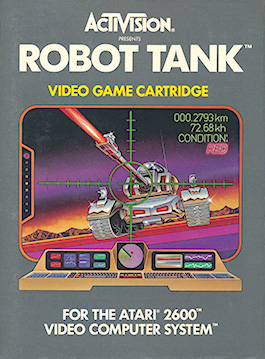
Robot Tank is a first-person shoot 'em up written by Alan Miller for the Atari 2600 and published by Activision in 1983. It is similar in design to Atari, Inc.'s Battlezone tank combat arcade video game and more so to its 2600 port. Robot Tank adds different systems which can individually be damaged—instead of the vehicle always exploding upon being shot—and weather effects.

Atlantis is a fixed shooter video game released by Imagic in July 1982 for the Atari 2600. It was written by Dennis Koble who also wrote Trick Shot, Solar Storm, and Shootin' Gallery for Imagic. Atlantis was ported to the Atari 8-bit computers, VIC-20, Intellivision, and Magnavox Odyssey 2. The game was inspired by Taito's 1981 Colony 7 arcade game.
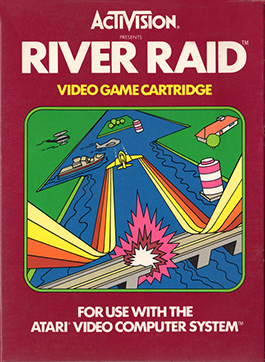
River Raid is a video game developed by Carol Shaw for the Atari Video Computer System and released in 1982 by Activision. The player controls a fighter jet over the River of No Return in a raid behind enemy lines. The goal is to navigate the flight by destroying enemy tankers, helicopters, fuel depots and bridges without running out of fuel or crashing.
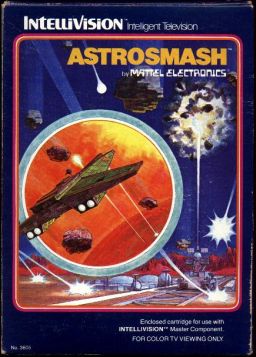
Astrosmash is a fixed shooter video game for the Intellivision console, designed by John Sohl, and released by Mattel Electronics in 1981. The player uses a laser cannon to destroy falling meteors, bombs, and other targets.
In the history of video games, the second-generation era refers to computer and video games, video game consoles, and handheld video game consoles available from 1976 to 1992. Notable platforms of the second generation include the Fairchild Channel F, Atari 2600, Intellivision, Odyssey 2, and ColecoVision. The generation began in November 1976 with the release of the Fairchild Channel F. This was followed by the Atari 2600 in 1977, Magnavox Odyssey² in 1978, Intellivision in 1980 and then the Emerson Arcadia 2001, ColecoVision, Atari 5200, and Vectrex, all in 1982. By the end of the era, there were over 15 different consoles. It coincided with, and was partly fuelled by, the golden age of arcade video games. This peak era of popularity and innovation for the medium resulted in many games for second generation home consoles being ports of arcade games. Space Invaders, the first "killer app" arcade game to be ported, was released in 1980 for the Atari 2600, though earlier Atari-published arcade games were ported to the 2600 previously. Coleco packaged Nintendo's Donkey Kong with the ColecoVision when it was released in August 1982.

Megamania is a fixed shooter video game developed by Steve Cartwright for the Atari 2600. It was published by Activision in 1982. A pilot of an intergalactic space cruiser has a nightmare where his ship is being attacked by food and household objects. Using the missile launcher from their space cruiser, the pilot fends of the attackers. The game was later released for the Atari 5200 and Atari 8-bit computers.
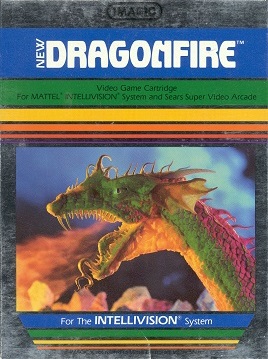
Dragonfire is a 1982 video game written by Bob Smith and published by Imagic. The player grabs treasure guarded by a dragon while avoiding fireballs. It was originally released for the Atari 2600 then ported to the Intellivision, VIC-20, Commodore 64, Apple II, ZX Spectrum, ColecoVision, and TRS-80 Color Computer.
Rob Fulop is an American game programmer who created two of the Atari 2600's biggest hits: the port of arcade game Missile Command and 1982's Demon Attack, which won Electronic Games' Game of the Year award. While at Atari, Fulop also ported Night Driver to the 2600 and Space Invaders to the Atari 8-bit computers.

Star Wars: The Empire Strikes Back is a scrolling shooter video game programmed by Rex Bradford for the Atari 2600 and published by Parker Brothers in 1982. It was the first licensed Star Wars video game. An Intellivision version was released in 1983.
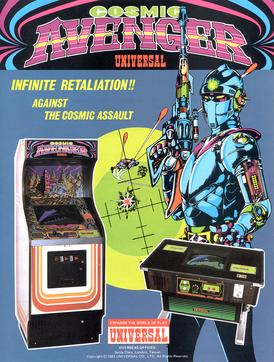
Cosmic Avenger is a scrolling shooter developed by Universal and released as an arcade video game in July 1981. It is part of the first wave shooters with forced horizontal scrolling which followed Konami's Scramble and Super Cobra from earlier in the year. It was released the same month as Vanguard. The final installment in Universal's Cosmic series, players take control of the Avenger space fighter and, as in Scramble, use bullets and bombs against enemy air and ground forces. The world is one continuous level made up of different areas.
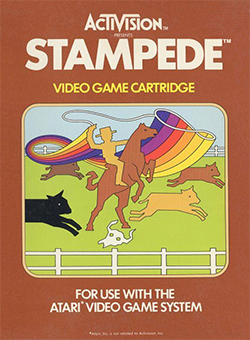
Stampede is a video game written by Bob Whitehead for the Atari Video Computer System and published by Activision in 1981. Stampede is a left-to-right, horizontally-scrolling, action game with a cattle round-up theme. An Intellivision version was released the following year.

Space Cavern is a 1982 fixed shooter video game for the Atari 2600 developed and released by Games by Apollo. Players control a spaceship commander who has landed on a planet and must defend the ship against its hostile creatures. Games by Apollo founder Pat Roper was impressed by the game Demon Attack and tasked Apollo member Dan Oliver with making a game very similar to it.

M Network was a video game division of Mattel that, in the 1980s, produced games in cartridge format for the Atari 2600 video game system.



















